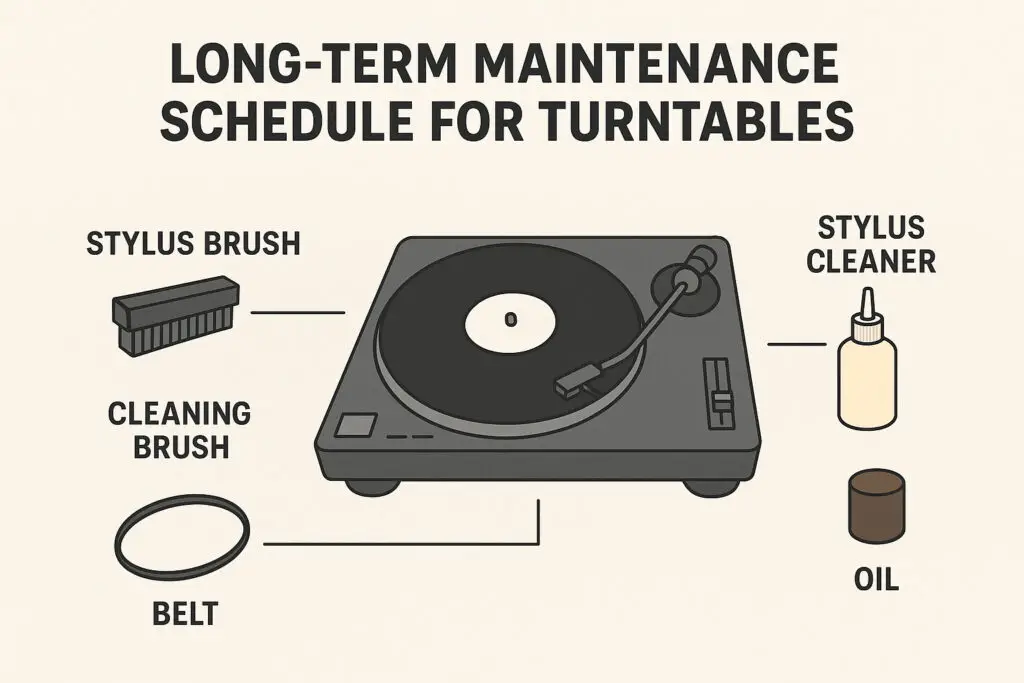A turntable is more than just a playback device — it’s a precision instrument. Like any mechanical system, it needs regular care to keep performing its best over time. Whether you own a modest mid-range deck or a high-end audiophile setup, proper maintenance helps ensure smooth operation, consistent sound quality, and extended component life.
This guide breaks down a long-term maintenance schedule for turntables, detailing what you should do daily, monthly, yearly, and beyond — plus a few pro tips for keeping your vinyl system healthy for decades.
1. Daily or After Each Listening Session
Clean the Stylus
Why: Dust and debris collect quickly on the stylus tip, dulling sound and wearing your records.
How:
- Use a soft stylus brush (brush from back to front, never side to side).
- Or use a gel stylus cleaner for deeper but gentle cleaning.
Frequency: Every session or at least every few hours of play.
👉 Result: Preserves record condition and ensures clear, distortion-free playback.
Wipe the Record Surface
Why: Static and dust attract unwanted noise and pops.
How:
- Use a carbon fiber brush or anti-static record brush before every play.
- If a record is visibly dirty, use a cleaning solution or record washer before spinning.
👉 Result: Protects both stylus and grooves from wear.
Cover the Turntable
Why: Dust is the biggest long-term enemy of turntable mechanics.
How:
- Always close the dust cover when not in use.
- If your turntable doesn’t have one, use a soft cloth or acrylic cover.
2. Monthly Maintenance
Check and Rebalance the Tonearm
Why: Over time, small bumps or movements can affect the tracking force and anti-skate settings, leading to uneven stylus wear.
How:
- Use a stylus force gauge to confirm the tracking weight matches the cartridge manufacturer’s recommendation.
- Check anti-skate alignment by ensuring the stylus doesn’t drift inward or outward during silent grooves.
👉 Result: Maintains correct tracking and prolongs cartridge life.
Inspect and Clean the Platter and Mat
Why: Dust or grime on the platter surface or mat can cause micro-slippage or resonance.
How:
- Remove the mat and wipe both surfaces with a lint-free cloth.
- For rubber mats, use mild soap and water; for cork or leather mats, dry-wipe only.
Check RCA and Ground Connections
Why: Loose or oxidized connections can introduce hum or channel imbalance.
How:
- Unplug, inspect, and clean the RCA plugs and grounding wire with contact cleaner.
- Reinsert firmly.
3. Every 6 to 12 Months
Inspect and Clean the Stylus Deeply
Even with regular brushing, microscopic buildup can accumulate.
- Use a stylus cleaning fluid or ultrasonic stylus cleaner (if available).
- Examine the tip under magnification — if it looks misshapen, it may be time for a stylus replacement (typically after 800–1,000 hours of play).
Replace or Clean the Drive Belt (for Belt-Drive Models)
Why: Belts stretch and lose elasticity over time, causing pitch instability or speed drift.
How:
- Check the belt for slack or residue.
- Clean the pulley and inner rim with isopropyl alcohol.
- Replace the belt if it’s sticky, loose, or glazed.
Typical lifespan: 2–5 years depending on usage and environment.
Lubricate the Main Bearing (if applicable)
Why: The spindle bearing is critical for smooth rotation.
How:
- Some turntables have a bearing well that can be lubricated with a few drops of specialized turntable oil.
- Always use the oil type recommended by your manufacturer.
- Avoid over-lubrication — excess can attract dust.
4. Every 1–2 Years
Check Cartridge Alignment and Overhang
Why: Small shifts over time (or accidental bumps) can misalign the cartridge, affecting tracking and channel balance.
How:
- Use a protractor or alignment gauge to ensure proper overhang and angle.
- Realign if necessary.
👉 Result: Prevents record wear and distortion.
Evaluate the Phono Preamp and Cables
Why: Even though electronics don’t require mechanical maintenance, connectors and circuits can degrade slightly.
How:
- Inspect cables for corrosion or fraying.
- Clean contacts using a high-quality contact cleaner.
- Ensure the preamp is free of dust and properly ventilated.
Test Speed Accuracy
Why: Speed drift can creep in over years of use, especially with belt or DC motor turntables.
How:
- Use a strobe disc or phone app to measure RPM accuracy.
- If speed is inconsistent, clean or replace the belt or check motor lubrication (for models that allow it).
5. Every 5+ Years
Replace Cartridge or Stylus Assembly
Even the best stylus wears down. Beyond 1,000–1,200 hours, sound quality and record safety decline.
- Upgrading or replacing your cartridge can restore clarity, dynamics, and detail.
Professional Tune-Up
If your turntable has complex mechanical parts (like suspended sub-chassis models), consider a professional inspection and calibration every 5 years.
A technician can:
- Measure tonearm resonance
- Replace bearings
- Calibrate motor speed and tension
6. Environmental Care: Year-Round Habits
- Temperature: Keep the turntable in a stable, moderate environment — avoid direct sunlight or high humidity.
- Placement: Isolate from vibrations (avoid placing near subwoofers or on hollow furniture).
- Dust Control: Regularly clean the area around the turntable to reduce airborne particles.
Summary: Your Turntable’s Longevity Timeline
| Maintenance Task | Frequency | Purpose |
|---|---|---|
| Stylus & Record Cleaning | Every session | Protects vinyl and stylus |
| Tonearm Balance Check | Monthly | Ensures correct tracking |
| Belt Inspection | 6–12 months | Prevents speed instability |
| Bearing Lubrication | 12 months | Reduces friction |
| Cartridge Alignment | 1–2 years | Preserves sound quality |
| Cartridge/Stylist Replacement | 5 years (approx.) | Restores full performance |
Final Thoughts
Turntables reward consistency. Regular maintenance doesn’t just preserve your records — it preserves the character of your system.
With just a few minutes of care each month, your turntable can deliver decades of reliable, high-quality playback, proving that analog’s enduring appeal lies not only in its sound, but in the craftsmanship and ritual that comes with it.

